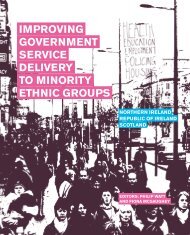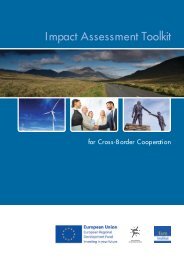4858 Mental Health Report - National University of Ireland, Galway
4858 Mental Health Report - National University of Ireland, Galway
4858 Mental Health Report - National University of Ireland, Galway
You also want an ePaper? Increase the reach of your titles
YUMPU automatically turns print PDFs into web optimized ePapers that Google loves.
Collaborative Practice and Policy<br />
Other organisations have been working for the purpose <strong>of</strong> promoting best<br />
practice and co-operation on a cross-border or international basis. Examples <strong>of</strong><br />
such international collaboration are the European Network on <strong>Health</strong> Promotion<br />
Policy and the International Collaborating Network <strong>of</strong> Community <strong>Mental</strong> <strong>Health</strong><br />
Leading Experiences.<br />
Effectiveness and evidence-based practice are two important areas within health<br />
promotion and this is also recognised internationally. The International Union <strong>of</strong><br />
<strong>Health</strong> Promotion and Education has developed standards for levels <strong>of</strong> evidence<br />
in health promotion effectiveness. The Campbell Collaboration has been formed<br />
with a membership drawn from 15 countries. Their mission is to provide high<br />
quality, sound evidence for policymakers, practitioners and the public to make<br />
well-informed decisions about public policy (Davies and Boruch 2001).<br />
Some collaborative health projects have evaluated the collaborative aspects <strong>of</strong><br />
their work - such as the Liverpool City <strong>Health</strong> Plan, which is part <strong>of</strong> the WHO<br />
<strong>Health</strong>y Cities Project. The effectiveness <strong>of</strong> joint working while developing this<br />
plan was examined by Costongs and Springett (1997). Many benefits and a few<br />
difficulties around joint working were highlighted in this project. Boundaries<br />
between organisations were ‘s<strong>of</strong>tened’ because <strong>of</strong> the joint working process.<br />
There was greater understanding and appreciation <strong>of</strong> what other people and<br />
organisations do, which created a force to carry something through. In addition,<br />
because the City <strong>Health</strong> Plan was developed together, it was open to discussion<br />
and therefore was more accountable and more likely to be jointly owned. Time<br />
was the constraint most frequently reported by project members. Achieving<br />
consensus was a time consuming activity, and the time needed for joint working<br />
was <strong>of</strong>ten in addition to people’s other responsibilities. In addition, participants<br />
had different ideas about the best way to work, and they had their own agendas<br />
and interests which made it difficult to compromise and to focus on a clear<br />
strategy. The key informants uniformly agreed that, even with its faults, joint<br />
working had been effective in developing the City <strong>Health</strong> Plan, but more<br />
attention needed to be paid to the process <strong>of</strong> people working together.<br />
Other work which has looked at the collaborative/partnership aspect was carried<br />
out by El Ansari et al (2001) in South Africa. A cluster evaluation <strong>of</strong> these<br />
partnerships demonstrated that, in addition to motivating all stakeholders to<br />
forge closer working relationships, it is necessary for partnerships to pay close<br />
attention to a variety <strong>of</strong> structural and operational dimensions, the lack <strong>of</strong> which<br />
can prove to be major constraints to effective partnership functioning.<br />
In the United Kingdom <strong>Health</strong> Action Zones (HAZ) were set up to encourage<br />
innovative methods <strong>of</strong> improving people’s health in some <strong>of</strong> the most deprived<br />
areas <strong>of</strong> England. Part <strong>of</strong> that process involved breaking down the traditional<br />
barriers preventing different agencies from working together. Partnership<br />
working was acknowledged by all HAZs to be essential in achieving HAZ<br />
84
















